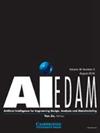Brain activity in constrained and open design: the effect of gender on frequency bands
IF 2.3
3区 工程技术
Q3 COMPUTER SCIENCE, ARTIFICIAL INTELLIGENCE
Ai Edam-Artificial Intelligence for Engineering Design Analysis and Manufacturing
Pub Date : 2022-02-15
DOI:10.1017/S0890060421000202
引用次数: 8
Abstract
Abstract This paper presents results from a design neurocognition study on the effect of gender on EEG frequency band power when performing constrained and open design. We used electroencephalography to measure the brain activity of 84 professional designers. We investigated differences in frequency power associated with gender of 38 female and 46 male designers, while performing two prototypical design tasks. The aim of the study was to explore whether gender moderates brain activity while performing a constrained versus an open design task. Neurophysiological results for aggregate activations across genders and between tasks indicate a main effect of gender for theta, alpha 2, and beta 1 frequency bands. Females show higher theta, alpha 2, and beta 1, namely in the right dorsolateral prefrontal cortex, right occipitotemporal cortex, secondary visual cortex, and prefrontal cortex in both tasks. Females show higher beta bands than males, in areas of the left prefrontal cortex, in the constrained design. While in the open design, females showed higher theta, alpha, and beta 2 in the left prefrontal cortex and secondary visual cortex for all frequency bands. Results within gender between tasks indicate higher theta and alpha in the prefrontal cortex in the constrained design for both genders. Whilst for open design, results indicate higher theta and alpha 1 in the right hemisphere and higher alpha 2 and beta bands across hemispheres for both genders. Results within gender reveal common brain areas and frequency bands in distinguishing constrained from open design.约束和开放设计中的脑活动:性别对频带的影响
摘要本文介绍了一项设计神经认知研究的结果,研究了性别对约束和开放设计时脑电频带功率的影响。我们用脑电图测量了84位专业设计师的大脑活动。我们调查了38名女性和46名男性设计师在执行两项原型设计任务时频率功率与性别的差异。这项研究的目的是探索性别是否会在执行受限设计任务和开放设计任务时调节大脑活动。跨性别和任务之间的神经生理学结果表明,性别对θ、α 2和β 1频段的主要影响。在这两项任务中,女性在右侧背外侧前额叶皮层、右侧枕颞叶皮层、第二视觉皮层和前额叶皮层中表现出更高的θ, α 2和β 1。在受限设计中,女性在左侧前额皮质区域的β带比男性高。而在开放式设计中,女性在所有频带的左前额叶皮层和次级视觉皮层都表现出更高的θ、α和β 2。不同性别任务之间的结果表明,在约束设计中,男女前额叶皮层的θ和α都较高。而在开放式设计中,结果表明,男女的右半球都有更高的α 1和α 2波段,而整个半球都有更高的α 2和β波段。性别内的结果揭示了在区分约束设计和开放设计时共同的大脑区域和频带。
本文章由计算机程序翻译,如有差异,请以英文原文为准。
求助全文
约1分钟内获得全文
求助全文
来源期刊
CiteScore
4.40
自引率
14.30%
发文量
27
审稿时长
>12 weeks
期刊介绍:
The journal publishes original articles about significant AI theory and applications based on the most up-to-date research in all branches and phases of engineering. Suitable topics include: analysis and evaluation; selection; configuration and design; manufacturing and assembly; and concurrent engineering. Specifically, the journal is interested in the use of AI in planning, design, analysis, simulation, qualitative reasoning, spatial reasoning and graphics, manufacturing, assembly, process planning, scheduling, numerical analysis, optimization, distributed systems, multi-agent applications, cooperation, cognitive modeling, learning and creativity. AI EDAM is also interested in original, major applications of state-of-the-art knowledge-based techniques to important engineering problems.

 求助内容:
求助内容: 应助结果提醒方式:
应助结果提醒方式:


